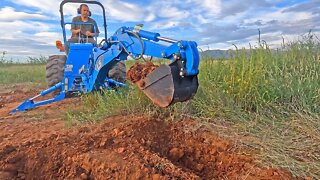Premium Only Content

If The Desert Was Green
FEATURECLIMATE CRISIS
Mass tree-planting programs in the desert often cause lasting damage to the ecosystems they are purportedly trying to repair.BY LAYLI FOROUDI JANUARY 27, 2022
RJIM MAATOUG, Tunisia — During the winter and spring, Mohamed Ben Ammar Ben Ammar often lets his camels go for a wander in the desert away from this village on Tunisia’s western edge. He doesn’t go with them. They know their way. They eat their fill of salty desert shrubs — zita, traganum, ephedra — and they always come back before nightfall.
Ben Ammar, who is 78 now, used to name each of the camels. It was a way to identify them in a herd mixed with animals belonging to others. “When I call the name, she comes,” he told me when I visited him recently. But that was before the government provided fodder, initially for free, as part of an elaborate project to turn the dusty dunes into a green oasis.
Though people had long lived here between the shifting sand dunes of the Great Eastern Erg and a vast but mostly dry salt lake called the Chott El-Jerid, Rjim Maatoug didn’t really exist as a village until around 1980, when the Tunisian government came in and built a school, a police station and a headquarters for the local section of the ruling political party. They also planted a plantation of more than 6,000 acres of palm trees. The project was set up by the ministry of defense, which describes it first and foremost as a “fight against desertification” by creating a green barrier between the sands and Tunisia’s expanding modern civilization.
By some estimates, desertification — when land in dry climates becomes barren — threatens some 70% of arid places around the world. The desert in these areas is said to be “expanding,” the land “damaged” and in need of improvement. These fears have justified policies to retaliate against the “encroaching” sand, often by planting non-native species, as well as to settle nomadic families and enclose communities within green walls of trees and plants.
Governments and multinational companies and organizations have long backed tree-planting campaigns to combat climate change by increasing global forest cover to pull carbon dioxide out of the atmosphere and to combat local problems like erosion and dust storms. Many claim to have successfully sowed billions of seeds and saplings.
At COP26 last November, 141 world leaders reaffirmed their commitments to the U.N. Convention to Combat Desertification, and earlier in the year a new round of funding was granted to the Great Green Wall project, an effort to construct a cordon of trees and plants nine miles wide and 5,000 miles long across the African continent from Senegal to Djibouti. The project aims to sequester around 275 million tons of carbon by 2030. Jeff Bezos has pledged $1 billion for it.
But a new generation of researchers is arguing that the old ideas about desertification are flawed — that they don’t encapsulate the challenges that drylands face due to climate change and environmental deterioration. They also point out that the “solutions” that are often implemented in arid areas, like multi-year tree-planting campaigns or intensive agriculture projects, are often incongruous with local ecologies and economies. “I am skeptical about the benefits of mass tree-planting schemes, especially in dryland areas where pastoralists live,” said Ian Scoones, a
AboutUs About us https://bit.ly/3GUPFOa
Contact us +919942258153 kvk.subadhra@gmail.com
Thank You Very Much for Sharing YourValuable Thoughts
https://bd5c5hscwcv6q0gkmle3kk08xa.hop.clickbank.net
-
 20:05
20:05
Green Dream Project
2 years agoInstalling Permaculture Basins To Green The Desert and Protect Our Foundation
3941 -
 LIVE
LIVE
Steven Crowder
3 hours ago🔴BREAKING: Trump Announces Major Trade Deal: What This Means For The Global Trade War
29,282 watching -
![BREAKING: Bitcoin is BIGGER Than Google [$100K Triggers Short Squeeze] | EP 1240](https://1a-1791.com/video/fww1/bc/s8/1/V/U/M/I/VUMIy.0kob-small-BREAKING-Bitcoin-is-BIGGER-.jpg) LIVE
LIVE
Simply Bitcoin
1 hour agoBREAKING: Bitcoin is BIGGER Than Google [$100K Triggers Short Squeeze] | EP 1240
554 watching -
 LIVE
LIVE
The Charlie Kirk Show
52 minutes agoThe First Trade Deal of Trump 2.0 + Exposing Planned Parenthood + AMA | Rose | 5.8.25
3,937 watching -
 LIVE
LIVE
The Shannon Joy Show
2 hours ago🔥🔥#MAHA Backlash! The Medical Freedom Community RAGES Against Trump’s Pick For Surgeon General - Casey Means. With Special Guest Jason Bassler Of The Free Thought Project!🔥🔥
321 watching -
 LIVE
LIVE
Benny Johnson
3 hours ago🚨BREAKING: New Pope Selected, White Smoke at Sistine Chapel | LIVE from Vatican Now
10,257 watching -
 LIVE
LIVE
The Mel K Show
1 hour agoTrump Tariffs are Working, Congress Remains Impotent, Unfathomable Fraud Continues to be Exposed
737 watching -
 LIVE
LIVE
The Dana Show with Dana Loesch
47 minutes agoBERNIE SANDERS DEFENDS FLYING PRIVATE JETS | The Dana Show LIVE on Rumble!
361 watching -
 LIVE
LIVE
NEWSMAX
7 hours agoThe Rob Carson Show LIVE (05/08/2025) | Call 1-800-922-6680 | NEWSMAX Podcasts
385 watching -
 39:11
39:11
The Rubin Report
2 hours agoFrom Broke to Rich to Broke to Influential Podcaster | Sean Kelly
24K4